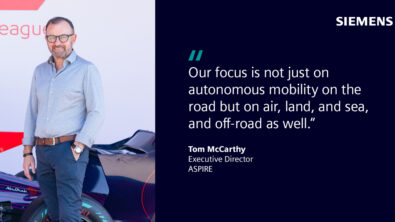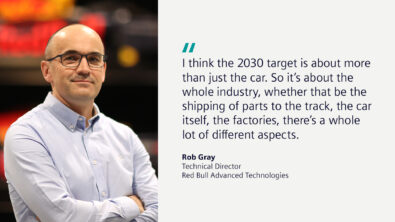Formula One Car Design with Bob Bell – Part 2
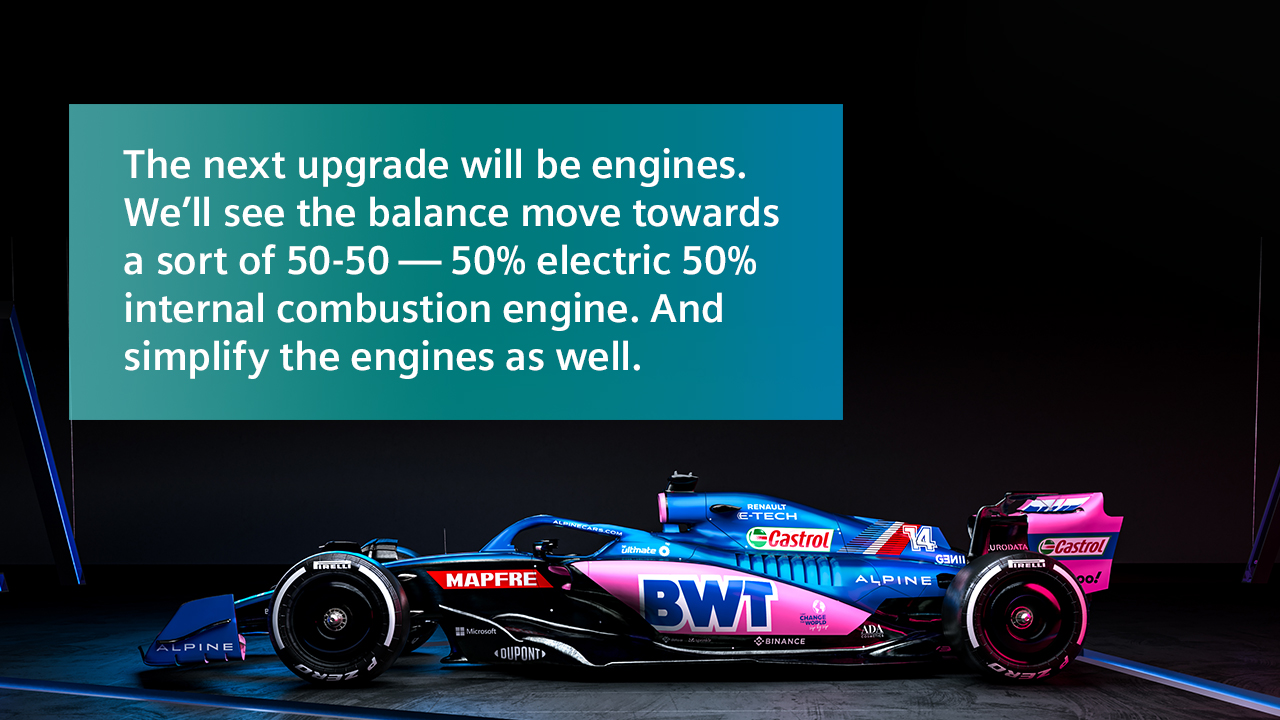
What happens to die hard fans that love roar of engines if F1 goes electric? Hear this and more…
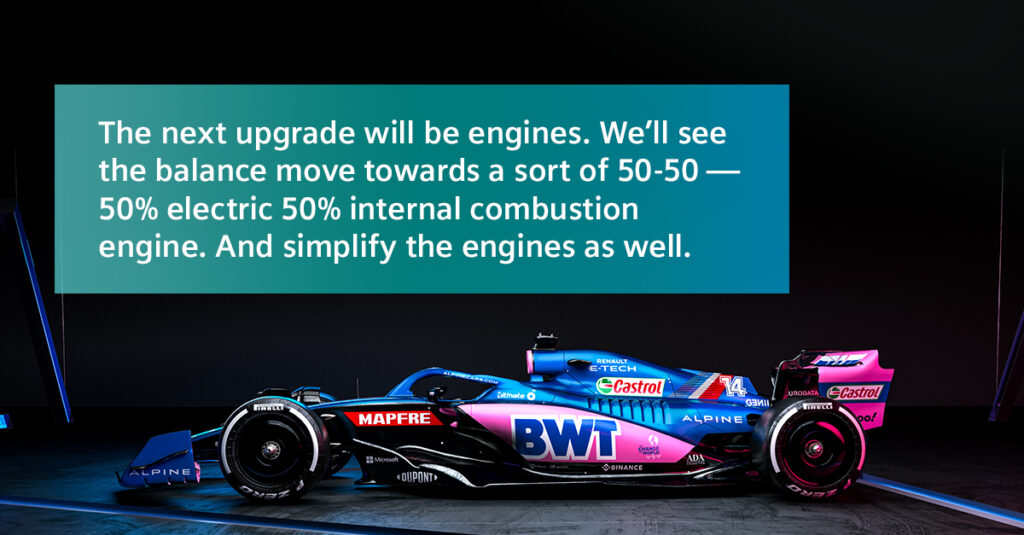
Alpine Formula 1 2022 Race car in striking bold pink and blue colors
Formula E vs Formula 1
Formula One is evolving to remain relevant and interesting in the 21st century.
A unique age where if it isn’t green enough, it can get ‘canceled’, and if it doesn’t trend on social media, it doesn’t matter!
This evolution involves making decisions affecting how the engine is designed as well as transforming the sport’s interaction with the fans. F1, like any other successful business, is implementing these changes one step at a time and learning as it goes.
In this episode, the second part of two, Ed Bernardon interviews Bob Bell, Strategic Advisor to BWT Alpine F1 team. He’s been in Formula One racing for 36 years and has won several championships with different teams. Today, he’ll walk us through the changes that he expects the sport to make in the next decade.
What You’ll Learn in this Episode:
- Changes in the engine that we can expect in the near future (01:51)
- The differences between Formula One and Formula E (03:27)
- The impact of increased focus on social media and off-the-track stories (06:30)
- The importance of a Drag Reduction System (DRS) (07:34)
Connect with Bob:
Connect with Ed Bernardon:
Ed Bernardon: Formula One has a global presence and appeals to its many fans through the roar of engines, fierce competition, and the ever-evolving cutting-edge technology. But what really drives the perceptions of the sport, and is racing still a technology leader especially when it comes to sustainability? Big changes are underway to keep racing relevant for society, and when it comes to Formula One how might the series evolve in the years to come as pressure mounts to both maintain technical leadership while improving sustainability?
Ed Bernardon: Welcome to the Future Car podcast. I’m your host Ed Bernardon, the VP of Automotive Strategy at Siemens Digital Industry Software. Today, we’re back for Part 2 of my interview with Bob Bell here in the midlands of England, the home of the Alpine Formula One team. As strategic advisor for the team and with 36 years of experience in Formula One, Bob has the perspective to discuss the future of F1 and the ways in which regulations and eco-friendly demands impact design of Formula One cars.
Bob and I explore how implementations of the new rules, new technology, and the so-called “outside the racetrack forces” such as the Drive to Survive series will impact the future of Formula One and its fanbase. Might there be a merger in store for Formula One and Formula E? Hear about this and more on Part 2 with Bob Bell.
Ed Bernardon: Great overview of the ’22 rules. But every four years, a new set of rules. You’ve got ’26 and 30. What’s going to happen in the next set of rule changes, you think?
Bob Bell: Well, as far as I know, these things are always subject to change in this world. The next major change will be a new set of engine regulations for 2026. So we’ve just done the chassis, this year, 2022. The next upgrade will be engines. The current philosophy for that is a different distribution of internal combustion engine generated power versus electric power. So I think we’ll see the balance move towards sort of 50-50 — 50% electric 50% internal combustion engine. And simplify the engines as well. Perhaps remove one of the energy harvesting devices, possibly the one that’s attached to the turbocharger to reduce costs, make the engine simpler and more attractive to other engine manufacturers. And you’ll also see continued and further use of biofuel content that I’m sure will grow. So yeah, I think that that’s a quite sensible step. When you look out beyond that, to 2030, then I think it opens the doors, potentially, for other sources of chemical energy, like hydrogen or whatever. There was some talk about it as early as 2026 but I think the realization was that it was a little bit too soon. But 2030, that all opens up, and I would expect to see that being explored quite heavily. Chassis wise, I’m not sure. I suspect nobody will really want to decide until we’ve seen over the course of a season how these cars have run. I think we’ll learn a lot from that and we’ll be able to better assess what we need to do to them for the next tranche of upgrades.
Ed Bernardon: So 2030, maybe it’s all electric, maybe it’s hydrogen power. Formula E has been out there for a while. They just showed a new car, a new concept in Monaco. Do you think Formula One and Formula E might merge in some way or become more closely related?
Bob Bell: Yeah, it’s a really tricky one. Because Formula E is a one-make series. You know, everybody races the same car. There is stuff you can do with the power unit, but the chassis and so on, it’s all the exact same way. Whereas Formula One, despite the regulations that we now have in 2022, is still a constructor championship where you design and make your own car. That’s probably a bigger difference between the Formula E and Formula One than the fact that Formula E is pure electric. As for the future, I think there is certainly a time to come, a space for both in the future. Would they merge? Possibly. I wouldn’t be surprised if that happened. But as it remains a minute, Formula One is the premier motor racing class and I expect it to remain so for a long time to come. But I think the power units in Formula One will just become more and more sustainable, and that might be they become all electric, or it might be that they continue to be hybrid with either fully sustainable fuels or with hydrogen or whatever.
Ed Bernardon: Maybe one way to go would be to take the advanced electric powertrain in Formula E and say, “Hey, take this powertrain and leave the freedom of design for the chassis.” It might be an easy path.
Bob Bell: Yeah, that’s one option. I think it’s fair to say that I suspect that at the minute, nobody really knows how that’s gonna play out, because the other thing is there are always big commercial forces in these decisions.
Ed Bernardon: It’s not always just about the technology.
Bob Bell: It’s not always. In fact, it usually isn’t just about the technology.
Ed Bernardon: Speaking of that, what about the Die Hard fan? I remember, a few years back, we used to have those screeching F1 Motors — oh, these new motors. F1 is ruined, it doesn’t sound the same. What’s going to happen to them? The Die Hard fan has been around forever, loves the roar of the internal combustion engine. Hydrogen batteries? Oh, come on.
Bob Bell: Well, hydrogen still makes pretty big bang when you set it off. But aside from that, the Die Hard fans will eventually die out, because they’re being replaced by younger followers of the sport. And in my experience, increasingly, the younger generation of followers of Formula One or just people who are interested in cars generally, are completely accepting of the fact that it’s all going to get a lot quieter, and it’s going to be a different world. And so, I think that it will just happen naturally. You know, the real Die Hard guys will eventually grow old and pass on. They’ll be replaced by people who don’t worry about that. I don’t see it as a problem, honestly.
Ed Bernardon: Well, you know, everyone likes social media. Everyone likes to watch Drive to Survive if you’re an F1 fan. So there’s an off-track element to a lot of this. How do you see that changing and growing?
Bob Bell: Well, it’s definitely going to grow. It’s very fair to say that one of the great things that Liberty has brought to the sport is this growth of building the sports’ image and following outside of the race track — as you say, things like Drive to Survive and increased social media. And that really has brought a whole new audience to Formula One, particularly again, the younger generation who wouldn’t have given Formula One a second thought, but now they see the people behind the stories and the human conflict on and off the track. It suddenly really awakened a whole new watching and following public, which is absolutely fantastic.
Ed Bernardon: You can vote for your favorite driver in a race.
Bob Bell: Vote for your favorite driver, yeah.
Ed Bernardon: Have you voted for a favorite driver?
Bob Bell: No, never. I wouldn’t, on principle.
Ed Bernardon: You’re not gonna put a vote in for Alonso?
Bob Bell: I’m completely agnostic about drivers.
Ed Bernardon: So a lot of what was done in ’22 was to make things more competitive. As you look to these next set of regulations, certainly there’s a sustainability aspect we’ve been talking about. But what do you think is going to be done to make it more competitive? What would you do? What do you think could be done to take the next steps that the ’22 car has done?
Bob Bell: Well, the first thing I’d say is — and this is kind of the way we usually do things in Formula One — I’d take my time and look at it properly, I wouldn’t just jump in with a shoot from the hip.
Ed Bernardon: Do you think they jumped in a little bit too fast on the ’22?
Bob Bell: I’m not suggesting that in this instance. Actually, I think this one was reasonably well handled. But we do have a habit in this business of knee-jerk reactions to perceived opinion. What I would say is that I think we need to give these regulations a chance, at least to the end of this year to see what it genuinely has done. Look at the statistics, do the analytics and decide whether or not they have worked. There is a mechanism, of course, on these cars, which we haven’t talked about, which is the DRS system, this Drag Reduction System that the drivers can use within a second of the car in front, which enables them to overtake more easily. We can adjust that, we can decide how often it’s deployed, how powerful it is, all of these things. So we have a tuning dial for allowing cars to overtake more easily. We can adjust that fairly readily. So I would urge, let’s see what happens this year. What we don’t want to do is we don’t want to go too far, particularly with something like the DRS system where overtaking becomes artificial. It’s just too easy. All you’ve got to do is get behind someone and you’re gonna overtake them. Well, is that racing? I’m not sure it is. I think you’ve got to work for it. So, I think we need to just be careful. So I would urge, let’s see what happens this year, how it’s perceived, what the results are, and then decide.
Ed Bernardon: You know, one of the things that has made qualifying more exciting, I think is the sprint qualifying. It’s like a little mini race. What would you think about in the sprint qualifying that you shake it up a little bit and put the fastest guy in the back?
Bob Bell: You could do it. I mean, these sorts of things, I mean, stuff like that has been talked about for years, along with things like wetting the track, because we always get great racing when the track’s wet. So why don’t we wet the track?
Ed Bernardon: Rain racing without rain.
Bob Bell: Yeah. So, you know, there are all sorts of artificial measures to do that and doing reverse grades is, of course, one of them. I’m always a little bit hesitant of these artificial measures. I think this is all about performance. It’s all about rewarding the best. And you gotta be careful you don’t take that too far. You level the playing field too much. It just becomes a lottery.
Ed Bernardon: Performance and awarding who does the best. That’s Formula One. Right? Bob, thank you so much for taking us through what’s happened with the ’22 rules, a little look at the future, and we definitely gonna plan on having you back here in ’26 and ’30 to see if your predictions come true. Is that a promise? Will you join us?
Bob Bell: As long as I’m still on this planet, I’ll come along. Thank you.
Ed Bernardon: Thank you so much, Bob. Some quick questions about Formula One. Are you ready? What percent of being fast is the driver versus the car?
Bob Bell: 50-50.
Ed Bernardon: 50-50? How much has driver input helped with the design of the car?
Bob Bell: The driver needs to be a really reliable sensor. So he needs to tell you what’s wrong with the car, not how to fix it.
Ed Bernardon: Favorite and least favorite track.
Bob Bell: I guess my favorite track is Spa. Beautiful setting, long historic, half of it is usually wet naturally, which I love. Least favorite track, I don’t know, maybe, Magny-Cours, somewhere like that. Narrow, not easy to overtake. Hotels are no use.
Ed Bernardon: You don’t get the yachts… You don’t get the nobility to pass in Monaco, but at least you have yachts there to make up for it. Right? Who designs the tracks? Does F1 have an input when tracks are designed?
Bob Bell: The FIA have a big input. They sanction all the circuits and they have favorite architects that they use for new circuits. So yes, there are bespoke architectural firms who design them in liaison with the FIA.
Ed Bernardon: How do you feel about F1 leaving some of the classic tracks in Europe for some of these streets circuits like, you know, in Miami or in Middle East?
Bob Bell: Well, there are two angles to that. You know, we’ve all got to get paid. And if the new tracks are paying, and the old tracks aren’t, well, then we have to go to the new ones. If you ask me as a purist where I’d rather be, I’d rather be racing at the historic circuits.
Ed Bernardon: Like Silverstone, which isn’t too far from here.
Bob Bell: Yeah. But Silverstone is a great track because not only does it pay its way, but it’s a beautiful track to race and fantastic fans.
Ed Bernardon: If you could change one thing in F1, instantly — it can be as unrealistic as you want it to be — to make things more exciting, to make things different, what would it be? What change would you make?
Bob Bell: I would tear up the rulebook and the only rule is must fit within a box. It’s that long, and that wide. Do what you like.
Ed Bernardon: That’s a simple rulebook, isn’t it? I mean, we could write it right here, if we wanted to.
Bob Bell: Couldn’t be simpler than that. And it’s that easy to please.
Ed Bernardon: What do you think about the controversial ending last year in 2021, in Abu Dhabi, between Louis and Max?
Bob Bell: Do you want an honest answer? I’m sick to death of hearing about it? Because everybody asks you that question. No, it’s racing. It’s full of controversy. It gets people talking about the sport. It’s great.
Ed Bernardon: All news gets your attention. There you go. How do you compare Formula One and Indy? What does IndyCar do better? What does Formula One do better? What could they learn from each other?
Bob Bell: Well, obviously, Indy has a far smaller global presence. It has some great racing and some great drivers. It really does. But it doesn’t obviously have the global reach. It doesn’t have the variation that Formula One does because you race on all sorts of tracks and all sorts of configurations. So I think, you know, they definitely have things that one can learn from one another. And, of course, we tried when we used to race in Indianapolis on half of the overall track.
Ed Bernardon: Yeah, I went to a few of those races.
Bob Bell: I’m not sure that was a great trial. But no, I think technically, I don’t know. There’s an awful lot of crossover, but I suspect that some commercial lessons could be learned from both sides.
Ed Bernardon: Have you been to the Indianapolis 500?
Bob Bell: No, no.
Ed Bernardon: Would you like to go sometime?
Bob Bell: I’m going to spend a year when I finally got the time to do it and do all the big races, do them all — do Indianapolis, and some quirky stuff like Pikes Peak.
Ed Bernardon: What’s the most exciting race you’ve ever been at?
Bob Bell: The famous race at Imola, I think it was, where Fernando kept Michael behind him for the last whatever it was 10 laps in the race.
Ed Bernardon: Let’s finish off with some personal questions. What was the first car you ever bought around?
Bob Bell: A Ford Capri?
Ed Bernardon: Did you pass your driver’s test on the first try?
Bo Bell: Yes.
Ed Bernardon: Autonomous cars — they’re going to create what’s known as a living room on wheels. You’re not driving, so you’ll be able to do whatever you want. So imagine you’re taking a five-hour trip. Liverpool to London or a long trip. What would you want in your living room on wheels?
Bob Bell: No internet connection. One thing I love about long-haul flights is you get on, you sit in your seat, they keep playing with food and drink, and nobody bothers you from the outside world. I hate now the fact that you’ve got an internet connection.
Ed Bernardon: And what would you do when you have… The internet’s gone, what are you going to do in that living room on wheels?
Bob Bell: Listen to music, read, keep half an eye out because I’m a traditionalist, and I don’t trust everything I’m told about technology.
Ed Bernardon: Make sure that autonomous car works. If you could have anyone alive today or that’s ever been alive with you for that five-hour ride, who would you pick?
Bob Bell: Richard Feynman, the famous American physicist.
Ed Bernardon: Really?
Bob Bell: Absolute genius and one of the world’s greatest educators and just a fun guy. He used to spend his time picking safes, playing the bongos.
Ed Bernardon: What question would you ask him?
Bob Bell: Why did he have to die so young?
Ed Bernardon: Greatest talent you have not related to anything you do at work.
Bob Bell: Avoiding other people.
Ed Bernardon: What do you wish you were better at?
Bob Bell: Playing the piano or the violin. I should qualify that I can’t play either at all.
Ed Bernardon: It would be easy to improve, then.
Bob Bell: It would be 100% gain very quickly.
Ed Bernardon: What do you wish you understood better?
Bob Bell: Quantum mechanics.
Ed Bernardon: A lot to understand there, that’s for sure. If you could have the answer to any question, what would it be?
Bob Bell: What is the basis of consciousness?
Ed Bernardon: Very good. Very good. If you could uninvent one thing, what would it be? It’s probably the internet based on what you said before.
Bob Bell: It’s not quite an invention, but if I could find a way of uninventing adverts on TV, on the internet, on the radio, I would definitely do that.
Ed Bernardon: I think a lot of people would agree with that. You could invent anything. You’ve got that genie bottle. Poof, there it is.
Bob Bell: Anti-gravity machine.
Ed Bernardon: Tell us something about yourself that your friends and family don’t know.
Bob Bell: I like classical organ music.
Ed Bernardon: Classical organ music. Well, there you have it. An inside look at Bob Bell. Thank you so much, Bob, for joining us today.
Bob Bell: It’s been a pleasure.
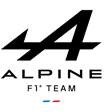
Bob Bell, Alpine Racing Strategic Advisor
Over the course of his career, Bob has worked in a technical or managerial role that has helped secure nine Constructors’ Championships and 10 Drivers’ Championships. He graduated from Queen’s University Belfast with a PhD in Aeronautical Engineering in 1982 he then worked with McLaren International as Head of Aerodynamics, Research and Development. He then moved to Benetton Formula One as Senior Aerodynamicist, Jordan Grand Prix as Head of Vehicle Technology, Renault F1 Technical and Managing Director roles, before joining Mercedes-Benz Grand Prix Ltd as Technical Director from 2011 to 2014. Bob joined Renault Sport Racing in 2016 as Chief Technical Officer, overseeing the outputs of both the Viry and Enstone sites to provide a strategic approach to their endeavours. Bob is currently Alpine Racing Strategic Advisor.
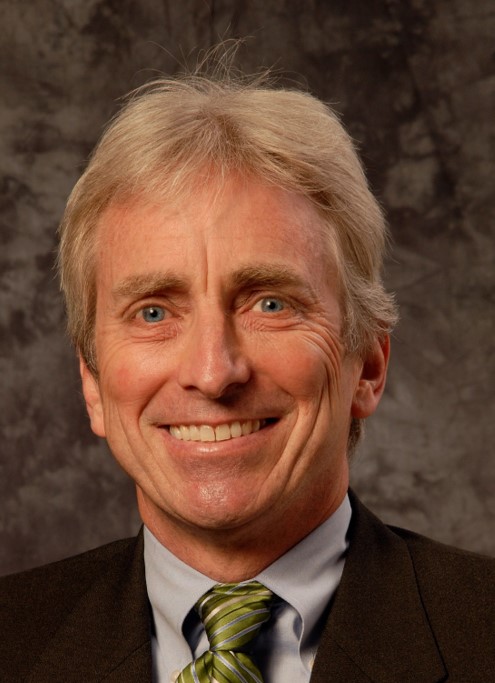
Ed Bernardon, Vice President Strategic Automotive Intiatives – Host
Ed is currently VP Strategic Automotive Initiatives at Siemens Digital Industries Software. Responsibilities include strategic planning in areas of design of autonomous/connected vehicles, lightweight automotive structures and interiors. He is also responsible for Future Car thought leadership including hosting the Future Car Podcast and development of cross divisional projects. Previously a founding member of VISTAGY that developed light-weight structure and automotive interior design software acquired by Siemens in 2011. Ed holds an M.S.M.E. from MIT, B.S.M.E. from Purdue, and MBA from Butler.
If you like this Podcast, you might also like:
- Anatomy of the new Formula One Car with Bob Bell- Part 1
- Carlo Mondavi’s Autonomous Electric Tractors for Sustainable, Affordable Farming – Part 1
- The Next Leap for Electric Vehicles with Will Graylin, Indigo Technologies – Part 1
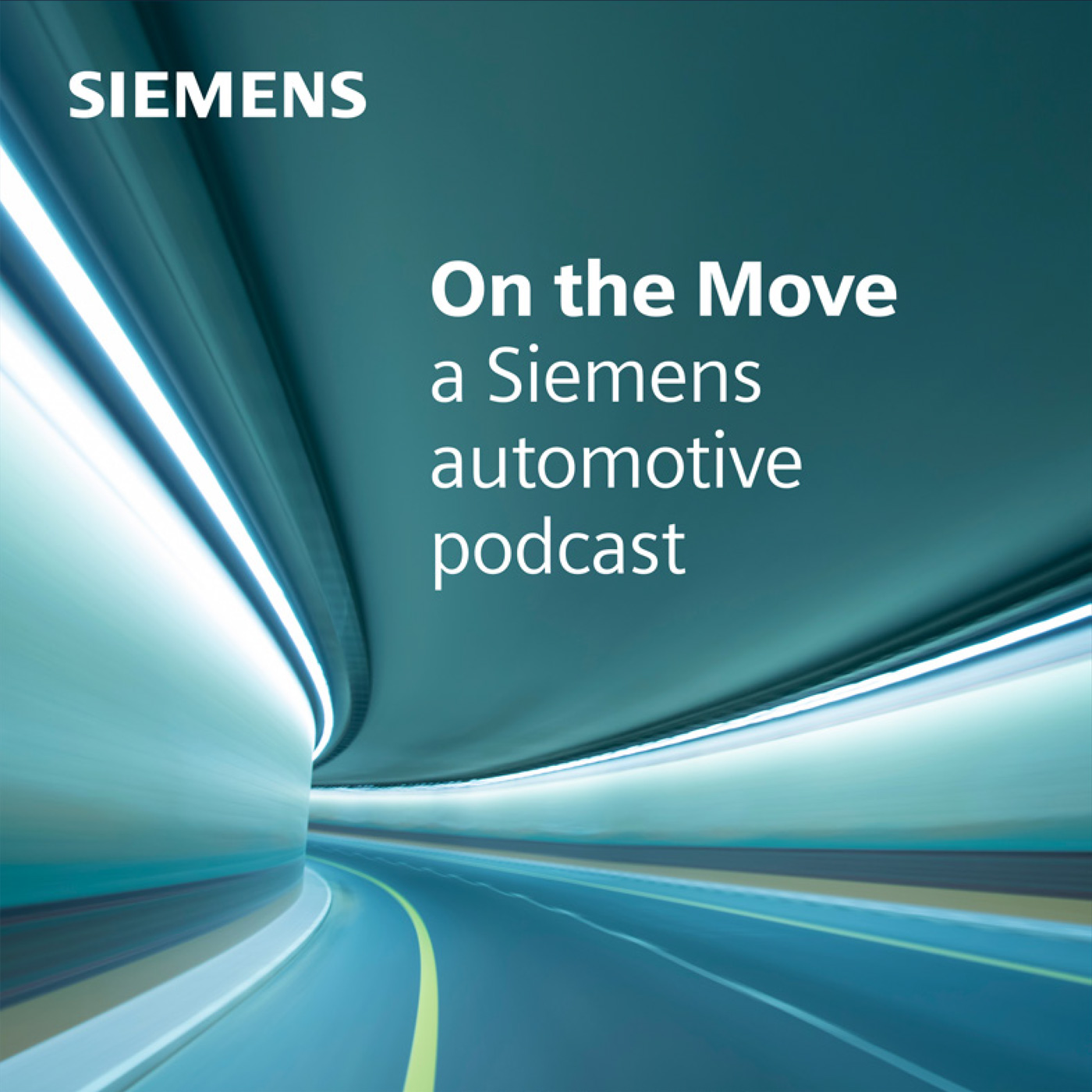
On the Move: A Siemens Automotive Podcast
The automotive and transportation industries are in the middle of a transformation in how vehicles are designed, made, and sold. Driven by an influx of new technologies, consumer demands, environmental pressures, and a changing workforce in factories and offices, automotive companies are pushing to reinvent fundamental aspects of their businesses. This includes developing more advanced and capable vehicles, identifying new revenue sources, improving customer experiences, and changing the ways in which features and functionality are built into vehicles.
Welcome to On the Move, a podcast from Siemens Digital Industries Software that will dive into the acceleration of mobility innovation amid unprecedented change in the automotive and transportation industries. Join hosts Nand Kochhar, VP of Automotive and Transportation, and Conor Peick, Automotive and Transportation Writer, as they dive into the shifting automotive landscape with expert guests from Siemens and around the industry. Tune in to learn about modern automotive design and engineering challenges, how software and electronics have grown in use and importance, and where the industries might be heading in the future.
